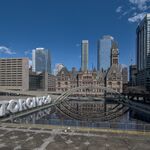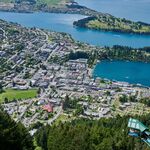S
spmarshall
Guest
JC Decaux has the exclusive contract for all street furniture, including bus shelters, "city information" boards, parking meters, newspaper boxes, etc in Chicago.
Similar to our new parking meters.


The City Information boards are just advertising. It seems as if one side is for municipal notices (such as the Chicago Library, note like everything by US cities temporary and permanent, it has "Richard M. Daley, Mayor" posted prominently - must be expensive to replace all that signage. I expecially disliked seeing that twit Kwame Kilpatrick's name all over Detroit). The other side are paid ads. I did not like them - served no real purpose and are perpendicular to the street, of course.

Note immediately outside the most busy/tourist areas, regular newspaper boxes can be found.

As Shawn Micallef noted, the bike infrastructure is a bit different. This was the only Toronto ring-and-post bike post, the rest (in the background) almost force bicycles to be locked perpendicular to the curb, an annoyance to pedestrians (though sidewalks downtown were mostly sufficiently wide).

While there aren't a lot of bike lanes downtown, or numbered bike routes, designated bike routes are identified with green signs. Also, recommended paths for bicyclists to various neighbourhoods and landmarks are posted.

One more thing I noticed is the old retro street lights all over Chicago, with few suburban standard lights. They really seem to be a Chicago thing, like our old Arc lamps.
For all those who hate anything of grit in Toronto (be it wooden poles and wires, streetcar overhead, so on), we don't have steel braces and wooden ties overhead some of our main streets. I liked riding the L myself, except on Lake Street, outside the loop, the trains run in alleys, allowing riders to see into backyards and windows.
Cumberland station on the Blue Line, in the median of the Kennedy Expressway. All Chicago stations, elevated, underground or in highway medians, are minimalist, and plain at best, otherwise old and dank. Being world class does not require fancy stations - the MTA is exhibit B in this case. Toronto stations may not be fancy, but they are generally clean and bright.

One of the Loop elevated stations. Note the wooden platforms. I thought it was neat.
CTA trains have automated announcements, which I thought were good, but a bit repetitive. The CTA’s announcements go like this: “The next stop is Library, State and Van Buren. Doors open on the right at Library, State and Van Buren. Transfer to Brown, Purple and Pink Line trains at Library, State and Van Buren.†In between, are regular announcements such as "Welcome to the CTA Red Line, run number 402" (if customers need to make a complaint or advisory), "Smoking is prohibited on all CTA vehicles, stations and platforms". A pleasant male voice, and soft, so it's not too hard to ignore. Unlike the nagging mommy who makes the annoying announcements in the TTC with the chime before.


The new Pink Line provides full service on the Douglas/Cermak branch of the Blue Line, and serves the Loop rather than the subway. The change was well promoted.

Quincy Station has been restored to resemble what a Loop station would have looked like 100 years ago, with certain liberties taken.









The other thing I liked about CTA, is when they got rid of tokens and cash fares at L stations (replaced with magnetic (like Metrocard, Translink, Travelcard) or touchless cards (like Oyster), the collectors became customer service agents, and are now out of their booths more often then they are, assisting people with the fare machines, providing directions, and they were very approachable. Since they were out of the booths, they were also providing an important security function. I can't wait for this for the TTC (an advantage of the smartcard), and screw Bob Kinnear et. al. if they put up a fight. The CTA station staff will actually confront violators, such as smokers, unlike TTC staff.
Though CTA trains are much less frequent than TTC subways, especially on weekends - every 8-10 minutes, and much shorter 45-foot cars (to run on the old steep curves of the L), and shorter trains - as short as 2 cars. Sometimes on weekends (never mind weekdays), capacity is a problem.

The interior of the old Union Station (which is beautiful) is not used for much, to get onto Amtrak or Metra Trains, you must go into a huge unerground maze to the east, under more modern office buildings. Not a great model for our Union Station, IMO.

I also took Metra, which has "gallery cars", which have second floors on each side of each car, with one seat. AMT has a few of these, and the design pre-dates the bilevels that GO pioneered. If you are without a ticket, the conductor will sell you a ticket, at a higher fee if you boarded at a station with an agent on duty. Interestingly, alcoholic beverages are permitted to be consumed on board unless otherwise noted.
Metra has a weekend fare, $5 for unlimited rides on any line, good for a Saturday and Sunday (could GO ever fathom offering something like this?). Most routes run weekends, but at best hourly, more commonly every 2 hours.
I took a train from LaSalle Station to Blue Island, where 8 minutes later on a Saturday, a Metra Electric train leaves for Randolph St, er, Millennium Station.


Next stop, Millennium Park, and my thoughts.
Similar to our new parking meters.


The City Information boards are just advertising. It seems as if one side is for municipal notices (such as the Chicago Library, note like everything by US cities temporary and permanent, it has "Richard M. Daley, Mayor" posted prominently - must be expensive to replace all that signage. I expecially disliked seeing that twit Kwame Kilpatrick's name all over Detroit). The other side are paid ads. I did not like them - served no real purpose and are perpendicular to the street, of course.

Note immediately outside the most busy/tourist areas, regular newspaper boxes can be found.

As Shawn Micallef noted, the bike infrastructure is a bit different. This was the only Toronto ring-and-post bike post, the rest (in the background) almost force bicycles to be locked perpendicular to the curb, an annoyance to pedestrians (though sidewalks downtown were mostly sufficiently wide).

While there aren't a lot of bike lanes downtown, or numbered bike routes, designated bike routes are identified with green signs. Also, recommended paths for bicyclists to various neighbourhoods and landmarks are posted.

One more thing I noticed is the old retro street lights all over Chicago, with few suburban standard lights. They really seem to be a Chicago thing, like our old Arc lamps.
For all those who hate anything of grit in Toronto (be it wooden poles and wires, streetcar overhead, so on), we don't have steel braces and wooden ties overhead some of our main streets. I liked riding the L myself, except on Lake Street, outside the loop, the trains run in alleys, allowing riders to see into backyards and windows.
Cumberland station on the Blue Line, in the median of the Kennedy Expressway. All Chicago stations, elevated, underground or in highway medians, are minimalist, and plain at best, otherwise old and dank. Being world class does not require fancy stations - the MTA is exhibit B in this case. Toronto stations may not be fancy, but they are generally clean and bright.

One of the Loop elevated stations. Note the wooden platforms. I thought it was neat.
CTA trains have automated announcements, which I thought were good, but a bit repetitive. The CTA’s announcements go like this: “The next stop is Library, State and Van Buren. Doors open on the right at Library, State and Van Buren. Transfer to Brown, Purple and Pink Line trains at Library, State and Van Buren.†In between, are regular announcements such as "Welcome to the CTA Red Line, run number 402" (if customers need to make a complaint or advisory), "Smoking is prohibited on all CTA vehicles, stations and platforms". A pleasant male voice, and soft, so it's not too hard to ignore. Unlike the nagging mommy who makes the annoying announcements in the TTC with the chime before.


The new Pink Line provides full service on the Douglas/Cermak branch of the Blue Line, and serves the Loop rather than the subway. The change was well promoted.

Quincy Station has been restored to resemble what a Loop station would have looked like 100 years ago, with certain liberties taken.









The other thing I liked about CTA, is when they got rid of tokens and cash fares at L stations (replaced with magnetic (like Metrocard, Translink, Travelcard) or touchless cards (like Oyster), the collectors became customer service agents, and are now out of their booths more often then they are, assisting people with the fare machines, providing directions, and they were very approachable. Since they were out of the booths, they were also providing an important security function. I can't wait for this for the TTC (an advantage of the smartcard), and screw Bob Kinnear et. al. if they put up a fight. The CTA station staff will actually confront violators, such as smokers, unlike TTC staff.
Though CTA trains are much less frequent than TTC subways, especially on weekends - every 8-10 minutes, and much shorter 45-foot cars (to run on the old steep curves of the L), and shorter trains - as short as 2 cars. Sometimes on weekends (never mind weekdays), capacity is a problem.

The interior of the old Union Station (which is beautiful) is not used for much, to get onto Amtrak or Metra Trains, you must go into a huge unerground maze to the east, under more modern office buildings. Not a great model for our Union Station, IMO.

I also took Metra, which has "gallery cars", which have second floors on each side of each car, with one seat. AMT has a few of these, and the design pre-dates the bilevels that GO pioneered. If you are without a ticket, the conductor will sell you a ticket, at a higher fee if you boarded at a station with an agent on duty. Interestingly, alcoholic beverages are permitted to be consumed on board unless otherwise noted.
Metra has a weekend fare, $5 for unlimited rides on any line, good for a Saturday and Sunday (could GO ever fathom offering something like this?). Most routes run weekends, but at best hourly, more commonly every 2 hours.
I took a train from LaSalle Station to Blue Island, where 8 minutes later on a Saturday, a Metra Electric train leaves for Randolph St, er, Millennium Station.


Next stop, Millennium Park, and my thoughts.






